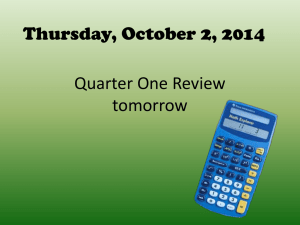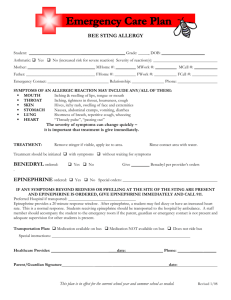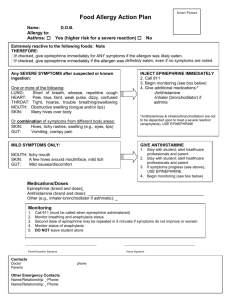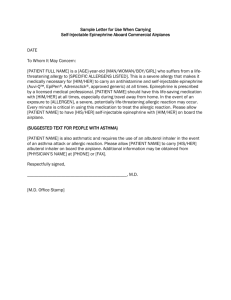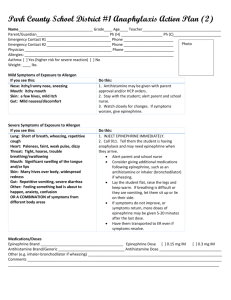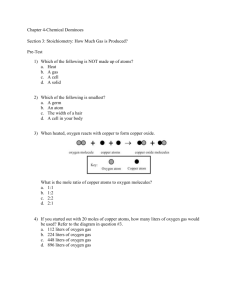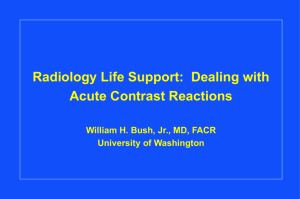Preparation of Stock Endotoxin Solution and Positive Control
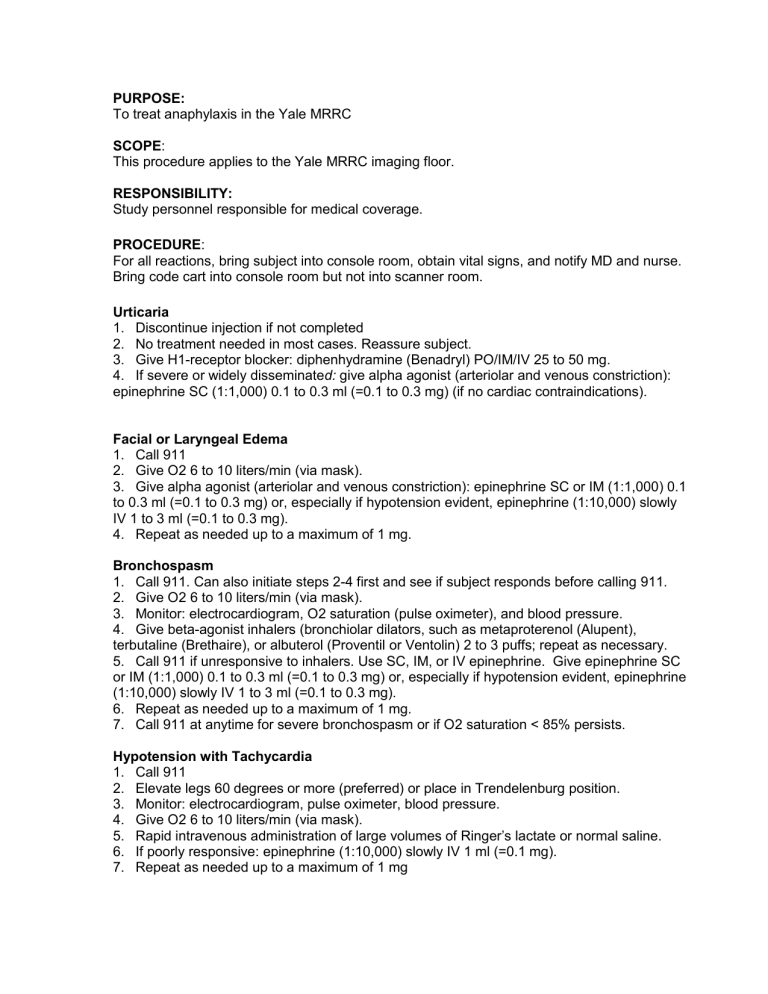
PURPOSE:
To treat anaphylaxis in the Yale MRRC
SCOPE :
This procedure applies to the Yale MRRC imaging floor.
RESPONSIBILITY:
Study personnel responsible for medical coverage.
PROCEDURE :
For all reactions, bring subject into console room, obtain vital signs, and notify MD and nurse.
Bring code cart into console room but not into scanner room.
Urticaria
1. Discontinue injection if not completed
2. No treatment needed in most cases. Reassure subject.
3. Give H1-receptor blocker: diphenhydramine (Benadryl) PO/IM/IV 25 to 50 mg.
4. If severe or widely disseminate d: give alpha agonist (arteriolar and venous constriction): epinephrine SC (1:1,000) 0.1 to 0.3 ml (=0.1 to 0.3 mg) (if no cardiac contraindications).
Facial or Laryngeal Edema
1. Call 911
2. Give O2 6 to 10 liters/min (via mask).
3. Give alpha agonist (arteriolar and venous constriction): epinephrine SC or IM (1:1,000) 0.1 to 0.3 ml (=0.1 to 0.3 mg) or, especially if hypotension evident, epinephrine (1:10,000) slowly
IV 1 to 3 ml (=0.1 to 0.3 mg).
4. Repeat as needed up to a maximum of 1 mg.
Bronchospasm
1. Call 911. Can also initiate steps 2-4 first and see if subject responds before calling 911.
2. Give O2 6 to 10 liters/min (via mask).
3. Monitor: electrocardiogram, O2 saturation (pulse oximeter), and blood pressure.
4. Give beta-agonist inhalers (bronchiolar dilators, such as metaproterenol (Alupent), terbutaline (Brethaire), or albuterol (Proventil or Ventolin) 2 to 3 puffs; repeat as necessary.
5. Call 911 if unresponsive to inhalers. Use SC, IM, or IV epinephrine. Give epinephrine SC or IM (1:1,000) 0.1 to 0.3 ml (=0.1 to 0.3 mg) or, especially if hypotension evident, epinephrine
(1:10,000) slowly IV 1 to 3 ml (=0.1 to 0.3 mg).
6. Repeat as needed up to a maximum of 1 mg.
7. Call 911 at anytime for severe bronchospasm or if O2 saturation < 85% persists.
Hypotension with Tachycardia
1. Call 911
2. Elevate legs 60 degrees or more (preferred) or place in Trendelenburg position.
3. Monitor: electrocardiogram, pulse oximeter, blood pressure.
4. Give O2 6 to 10 liters/min (via mask).
5. Rapid intrave nous administration of large volumes of Ringer’s lactate or normal saline.
6. If poorly responsive: epinephrine (1:10,000) slowly IV 1 ml (=0.1 mg).
7. Repeat as needed up to a maximum of 1 mg
Hypotension with Bradycardia (Vagal Reaction)
1. Call 911.
2. Secure airway: give O2 6 to 10 liters/min (via mask)
3. Monitor vital signs.
4. Legs elevated 60 degrees or more (preferred) or Trendelenburg position.
5. Secure IV access: rapid administration of Ringer’s lactate or normal saline.
6. Give atropine 0.6 to 1 mg IV slowly if patient does not respond quickly to steps 2 to 4.
7. Repeat atropine up to a total dose of 0.04 mg/kg (2 to 3 mg) in adult.
Hypertension, Severe
1. Call 911.
1. Give O2 6 to 10 liters/min (via mask).
2. Monitor electrocardiogram, pulse oximeter, blood pressure.
3. Give nitrog lycerine 0.4 mg tablet, sublingual (may repeat °— 3); or, topical 2% ointment, apply 1 inch strip.
4. If no response, consider labetalol 20 mg IV, then 20 to 80 mg IV every 10 minutes up to
300 mg.
Seizures or Convulsions
1. Keep patient safe and comfortable.
2. Give O2 6 to 10 liters/min (via mask).
3. Call 911 if convulsions persist longer than 5 minutes and consider diazepam (Valium) 5 mg IV (or more, as appropriate) or midazolam (Versed) 0.5 to 1 mg IV.
4. If longer effect needed, consider phenytoin (Dilantin) infusion 15 to 18 mg/kg at 50 mg/min.
5. Careful monitoring of vital signs required, particularly of pO2 because of risk to respiratory depression with benzodiazepine administration.
6. Call 911 for status epilepticus,
Pulmonary Edema
1. Call 911
2. Give O2 6 to 10 liters/min (via mask).
3. Elevate torso.
4. Give diuretics: furosemide (Lasix) 20 to 40 mg IV, slow push.
5. Consider giving morphine (1 to 3 mg IV).
